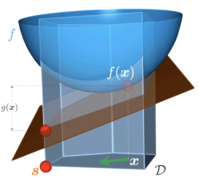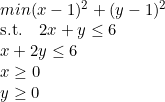Frank-Wolfe
Author: Adeline Tse, Jeff Cheung, Tucker Barrett (SYSEN 5800 Fall 2021)
Introduction
The Frank-Wolfe algorithm is an iterative first-order optimization algorithm for constrained convex optimization, first proposed by Marguerite Frank and Philip Wolfe from Princeton University in 1956.[1] It is also known as the “gradient and interpolation” algorithm or sometimes the “conditional gradient method” as it utilizes a simplex method of comparing an initial feasible point with a secondary basic feasible point to maximize the linear constraints in each iteration to find or approximate the optimal solution.
Advantages of the Frank-Wolfe algorithm include that it is simple to implement, it results in a projection-free computation (that is, it does not require projections back to the constraint set to ensure feasibility), and it generates solution iterations that are sparse with respect to the constraint set. However, one of the major drawbacks of Frank-Wolfe algorithm is the practical convergence, which can potentially be an extremely slow computation process. Nonetheless, new sub-method has been proposed to accelerate the algorithm by better aligning the descent direction while still preserving the projection-free property. [2] Therefore, despite the downside of Frank-Wolfe algorithm, the numerous benefits of this algorithm allow it to be utilized in artificial intelligence, machine learning, traffic assignment, signal processing, and many more applications.
Theory & Methodology

The Frank-Wolfe algorithm uses step size and postulated convexity, which formulates a matrix of positive semidefinite quadratic form. Just like a convex function yields a global minimum at any local minimum on a convex set, by the definition of nonlinear programming, the concave quadratic function would yield a global maximum point at any local maximum on a convex constraint set.
The methodology of the Frank-Wolfe algorithm starts with obtaining the generalized Lagrange multipliers for a quadratic problem, PI. The found multipliers are considered solutions to a new quadratic problem, PII. The simplex method is then applied to the new problem, PII, and the gradient and interpolation method is utilized to make incremental steps towards the solution of the original quadratic problem, PI. This is performed by taking an initial feasible point, obtaining a second basic feasible point along the gradient of the objective function at the initial point, and maximizing the objective function along the segment that joins these two points. The found maximum along the segment is utilized as the starting point for the next iteration.[1] Using this method, the values of the objective function converge to zero and in one of the iterations, a secondary point will yield a solution.
Proof
- is a matrix
- is a matrix
- is a matrix
- and are and matrices respectively
- is the gradient
PI is represented by the following equations using matrix notation:
Since PI is feasible, any local maximum found that is contained within the convex constraint set is a global maximum. Then by utilizing Kuhn and Tucker's generalizations of the Lagrange Multipliers of the maximization of the objective function , is considered the solution of PI.
By the Duality Theorem,
Therefore, the solution for PI is only valid if:
Since
The completion of the generalized Lagrangian shows that positive variables exist for PI, thus a feasible solution exists.
Based on the concavity of ,
If satisfies (where x is a solution if for some ), then
By the Boundedness Criterion and the Approximation Criterion,
The Frank-Wolfe algorithm then adds a non-negative variable to each of the inequalities to obtain the following:
- and are and matrices respectively
Thus, the PII problem is to obtain search vectors to satisfy , and is considered a solution of PI if belongs to the convex cone spanned by the outward normals to the bounding hyperplanes on which lines as shown in Figure 1.
Algorithm
The Frank-Wolfe algorithm can generally be broken down into five steps as described below. Then the loop of iterations continues throughout Steps 2 to 5 until the minimum extreme point is identified.
Step 1. Define initial solution
If is the extreme point, the initial arbitrary basic feasible solution can be considered as:
The letter denotes the number of iterations.
Step 2. Determine search direction
Search direction, that is the direction vector is:
and are feasible extreme points and belong to where is convex
First-order Taylor expansion around and problem is now reformulated to LP:
Step 3. Determine step length
Step size is defined by the following formula where must be less than 1 to be feasible:
Step 4. Set new iteration point
Step 5. Stopping criterion
Check if is an approximation of , the extreme point. Otherwise, set and return to Step 2 for the next iteration.
In the Frank-Wolfe algorithm, the value of descends after each iteration and eventually decreases towards , the global minimum.
Numerical Example
Consider the non-linear problem below.

Step 1. Choose a starting point
Begin by choosing the feasible point (0,0)
Step 2. Determine a search direction The search direction is obtained by solving linear problem subject to the constraints defined earlier The solution of this linear problem can be obtained via any linear programming algorithm, ie. enumeration with the feasible region's extreme points, the simplex method or GAMS. The solution to the linear problem is
The direction for this iteration is found by
The next point is found by
Step 3. Determine Step Length We evaluate z(4t, 4t) to obtain t.
Step 4. Set New Iteration Point Therefore
Step 5. Perform Optimality Test If the following equation yields a zero, the optimal solution has been found for the problem.
ITERATION 2
Step 1. Utilize new iteration point as the starting point
At this point, because the gradient of the new starting point is [0,0], the optimality test will yield 0; therefore [1,1] is the optimum solution to the non-linear problem.
Conclusion
The Frank-Wolfe algorithm is one of the key techniques in the machine learning field. The algorithm features favor linear minimization, simple implementation, and low complexity. By using the simplex method that requires little alteration to the gradient and interpolation in each iteration, the optimization of the linearized quadratic objective function can be performed in a significantly shorter runtime and larger datasets can be processed more efficiently. Therefore, even though the convergence rate of Frank-Wolfe algorithm is slow due to the search for naive descent directions in each iteration, the benefits that the algorithm brings still outweigh the disadvantages. With the main characteristics of being projection-free and the capability of producing solutions for sparse structures, the algorithm gained popularity with many use cases in machine learning.
References
- ↑ 1.0 1.1 Frank, M. and Wolfe, P. (1956). An algorithm for quadratic programming. Naval Research Logistics Quarterly, 3(1-2):95–110.
- ↑ Combettes, C.W.. and Pokutta, S. (2020). Boosting Frank-Wolfe by chasing gradients. International Conference on Machine Learning (pp. 2111-2121). PMLR.
- ↑ Jaggi, M. (2013). Revisiting Frank-Wolfe: Projection-free sparse convex optimization. Inerational Conference on Machine Learning (pp.427-435). PMLR.

![{\displaystyle [n\times 1]}](https://wikimedia.org/api/rest_v1/media/math/render/svg/7b8626c8f96ac82b5c7770fde351ede0137e3992)

![{\displaystyle [m\times n]}](https://wikimedia.org/api/rest_v1/media/math/render/svg/60b617e206c9fb5fae1e89d73a33c75e826480c5)

![{\displaystyle [n\times n]}](https://wikimedia.org/api/rest_v1/media/math/render/svg/47fc57498a8040ee9d4117056a6663e0b165ec6f)


![{\displaystyle [1\times n]}](https://wikimedia.org/api/rest_v1/media/math/render/svg/2dc04bdc0bddba51eeca7eed8515ca35f1d79662)
![{\displaystyle [1\times m]}](https://wikimedia.org/api/rest_v1/media/math/render/svg/40df39f1cf3304969234e1835f02288e27e6599f)








![{\displaystyle \delta f(x_{0})x_{0}=Max\,[\,\delta f(x_{0})w\,|\,w\geq 0,Aw\leq b],\quad where\;w\;{\text{is an}}\;[n\times 1]\;{\text{matrix}}}](https://wikimedia.org/api/rest_v1/media/math/render/svg/e786b861c24421494b439bbaeac15880c021e682)
![{\displaystyle Min\,[\,ub\,|\,u\geq 0,\,uA\geq \delta f(x_{o})],\quad where\;u\;{\text{is a}}\;[1\times m]\;{\text{matrix}}}](https://wikimedia.org/api/rest_v1/media/math/render/svg/4355b9102d4d9a6d4d44fbd0c1e7c63c421d1495)
![{\displaystyle Max\,[\,\delta f(x_{0})x_{0}-ub\,|\,u\geq 0,uA\geq \delta f(x_{0})]=0}](https://wikimedia.org/api/rest_v1/media/math/render/svg/19b1fb7db0d7158b728e880c4009dbc7cc654fe3)














![{\displaystyle [m\times 1]}](https://wikimedia.org/api/rest_v1/media/math/render/svg/1fcc3d1a24030bca3afee3d5d4f892b108a2496c)
















![{\displaystyle minimize_{\alpha \in [0,1]}\,f(x_{k}+\alpha p_{k})}](https://wikimedia.org/api/rest_v1/media/math/render/svg/3e53164c3ceec36747812ddc5f032fdb60932d15)





![{\textstyle \nabla f(0,0)=z_{0}=[-2,-2]}](https://wikimedia.org/api/rest_v1/media/math/render/svg/396bd05ed3270896af81ab3e15446c52ea70b0f8)




![{\textstyle [2,2]-[-2,-2]=[4,4]}](https://wikimedia.org/api/rest_v1/media/math/render/svg/5bc503d675157b9ee7284e4535d4897e19116ef3)
![{\textstyle x_{1}=x_{0}+t*dir[0]}](https://wikimedia.org/api/rest_v1/media/math/render/svg/d870d460185548efb9a1c99b1e685fd10b622298)
![{\textstyle x_{1}=x_{0}+t*[4,4]}](https://wikimedia.org/api/rest_v1/media/math/render/svg/2f56e6e3a6bd4acd11703c38126e02b4ff4043a3)


![{\textstyle x_{1}=[0,0]+16/64*[4,4]=[1,1]}](https://wikimedia.org/api/rest_v1/media/math/render/svg/e96123b84177708c4cab3af1656b4463999de361)
![{\textstyle x_{1}=\nabla f(x_{0})*dir[0]}](https://wikimedia.org/api/rest_v1/media/math/render/svg/9aeae691a0df3daad79cf7e688739761290228ca)
![{\textstyle x_{1}=\nabla f(x_{0})*dir[0]=-2*2+-2*2=-8}](https://wikimedia.org/api/rest_v1/media/math/render/svg/be2497585b8f6dd1b467084c3b2931c91025ac4e)
